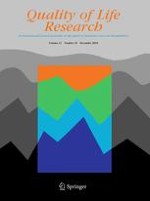01-12-2014
Physical activity and health-related quality of life: US adults with and without limitations
Gepubliceerd in: Quality of Life Research | Uitgave 10/2014
Log in om toegang te krijgenAbstract
Purpose
The purpose of this study was to examine the dose–response relationship between physical activity (PA) and health-related quality of life (HRQOL) among adults with and without limitations.
Methods
We dichotomized HRQOL as ≥14 unhealthy (physical or mental) days (past 30 days), or <14 unhealthy days. By using a moderate-intensity minute equivalent, PA categories were as follows: inactive, 10–60, 61–149, 150–300, and >300 min/week. Persons with limitations reported having problems that limited their activities or required use of special equipment. Age-adjusted prevalence estimates and logistic regression analyses were performed with 2009 Behavioral Risk Factor Surveillance System data (n = 357,665), controlling for demographics, BMI, smoking, and heavy alcohol use.
Results
For adults without limitations, the odds of ≥14 unhealthy days were lower among adults obtaining any PA (10–60 min/week, AOR = 0.79, 95 % CI 0.70, 0.88), compared with those inactive. A quadratic trend (P < 0.001) indicated enhanced HRQOL with each PA level, but improvements were less marked between lower and upper sufficient PA categories (150-300 and >300 min/week). Because of a significant age interaction, persons with limitations were stratified by age (18–34, 35–64, and 65+ years). Findings for persons aged 35 years or older with limitations were similar to those without limitations. Lower odds of poor HRQOL for persons aged 18–34 years with limitations were associated with recommended levels of PA (150–300 min/week; AOR = 0.61, 95 % CI 0.43, 0.88 and >300 min/week; AOR = 0.58, 95 % CI 0.43, 0.80).
Conclusions
PA is positively associated with HRQOL among persons with and without limitations.
